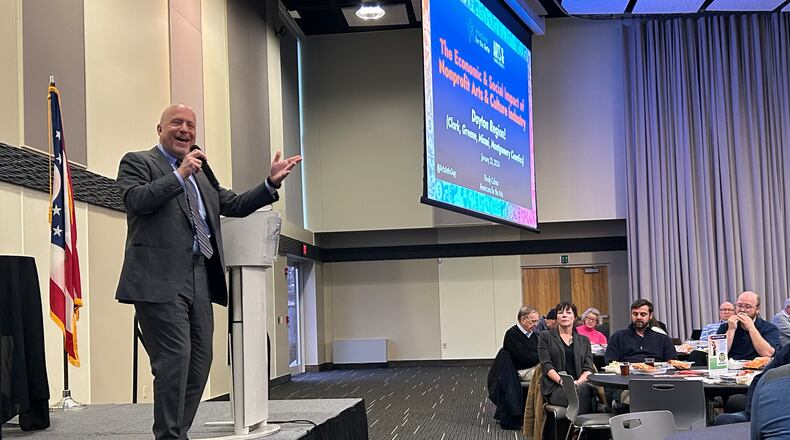Randy Cohen, vice president of research for Americans for the Arts, was the guest presenter and shared local data from surveys collected by nonprofit arts organizations including the SSO and Springfield Civic Theatre in 2023. Culture Works, a Dayton-based nonprofit organization working for funding, advocacy and service for arts programs, conducted the surveys with Arts & Economic Prosperity 6 (AEP6), an economic and social impact study of the country’s nonprofit arts and culture industry.
“We think of ticket sales first, but there is so much more economic impact beyond that. We’re going to change the conversation of the arts, to think a little differently,” Cohen said in his opening remarks.
The survey is done every five years, and the arts industry was dealt a huge blow since the previous survey – the COVID-19 pandemic. Venues were shut down and many nonprofit arts jobs were lost amid it.
But there was an upside in that personal creation or expression led 30 percent of people to discover new skills and distractions, and the arts were part of it.
The regional survey found local people attending arts in the region spent an average of $21.60, not including a ticket, on food, drinks, transportation, child care and other factors. It also revealed that about 17 percent of attendees came from outside of the four-county region and spent $32.85 on average.
“This is where you can really see the impact,” Cohen said. “Nobody thinks of the arts as an industry until you talk about it.”
Cohen used examples that people may not think of that are part of the total package such as when looking for an event or place to visit, people often start with a website that someone paid to have designed and a host. Visiting a museum or facility, you may park in a parking garage and an employee may take your money and/or ticket.
People may have a meal or drinks before or after a visit or at an event and that benefits the restaurant, waiter, those who grow the food, people who deliver it and so on. Even those who print materials for organizations such as programs are part it.
Ohio’s total art and culture industry is a $23.9 billion industry, accounting for 3.2 percent of the state economy and supports 158,206 jobs. The Dayton region supports 4,490 arts-related jobs.
Nationally, the survey was done in 24 languages to reflect the various cultures. It covered 373 regions nationally, from populations of 4,000 and up and showed in 2021 that arts took in $1.02 trillion nationally.
In addition, the data revealed arts bring in high volunteer rates, spark creativity and innovation, improve academic performance in students, in healthcare, mental health and have social impact.
It also found 72 percent of Americans believe arts help culturally, and 81 percent of the population surveyed said arts are “a positive experience in a troubled world.”
Cohen said he hopes the audience takes away all of this and spreads the findings to others to value and support the arts opportunities communities have and what could happen if they didn’t.
“It’s so easy to take arts and culture for granted. We have some work still to do,” he said. “Anything you can do to advance arts in your community is important and you’re important for doing it. We have to be relentless in our messaging.”
He asked the group to think about three things: What is the message, who gets the message and who delivers the message?
That resonated with Lou Ross, SSO executive director, who’d attended events for previous surveys and knew a lot of the presentation, but still took things away he can use going forward.
“His message about messaging was big. This is what we’ll be looking at in the information we put out in the future,” Ross said.
The audience was made up of community members from various arts organizations, board members, interested citizens, community leaders and even students.
Sophia Lopez, a sophomore at Cedarville High School who lives in Springfield, got interested in the presentation after reading a News-Sun preview story about it. Her mom thought it would just be a business-type affair, but Lopez thought enough of it to take off school for.
Part of it came in her interest in pursuing a career in urban planning upon graduation and said arts was part of that.
“I really appreciated the study, especially learning that is was accessible to other languages and shows how important the arts are,” she said.
Lopez and her family enjoy attending the Summer Arts Festival, the Lunch on the Lawn series and the Springfield Museum of Art. She plays violin in the Springfield Symphony Youth Orchestra as Cedarville doesn’t have such a program, another opportunity she’s appreciative of.
Larry Coressel, who lives in Springfield and works at classical music station WDPR in Dayton, said it encourages what he does in promoting the arts in Dayton and Springfield.
“I’ve always said we need to do promote arts they have impact and always to keep pushing,” he said.
About the Author
